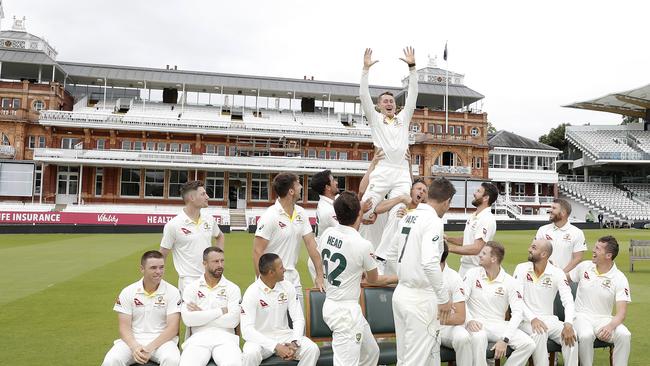Ashes 2019: The home of every cricketer’s dream
England v Australia at Lord’s: what cricket follower does not feel their sap rise at such a prospect?

Around Lord’s, Australians have long moved with a certain confidence. According to Wisden, the first colonial cricketers to play at Lord’s in May 1878 arrived “in such a quiet and unpretentious way” as to pass unrecognised. They left that evening rather better known, having routed the Marylebone Cricket Club, led by W. G. Grace, for 33 and 19, to win by nine wickets.
No Australian is peddling the hashtag #FortressLord’s: the visitors have lost two of their last three Tests in NW8. Yet the respective records remain remarkable. Against all other comers, England have won 48 and lost 17 Test matches at Lord’s. Against Australia, the ratio, at seven and 15, is nearly reversed.
In the 20th century, England won the grand total of one Ashes Test at cricket’s most storied ground. In the 21st century, Australia have lost one of 11 one-day internationals.
Their coach, Justin Langer, loves the place: he averaged nearly 60 in first-class cricket there. So does his assistant and amigo Steve Waugh: his average from four Lord’s Tests was 115.6. “It is every Australian cricketer’s dream to be selected to play in a Test at Lord’s,” Waugh has written. “Once inside this fabled arena, you always get a sense that you are in a place that is steeped in tradition.”
There is a solid sense, moreover, of tradition as a joint enterprise. On a 1944 visit to London, the country’s wartime prime minister John Curtin famously declared that “Lord’s and its traditions belong to Australia just as much as to England” and that Australians would “always fight for those 22 yards”.
Australian centurions at Lord’s read like a parade of champions: Victor Trumper, Charlie Macartney, Donald Bradman, Arthur Morris, Lindsay Hassett, Keith Miller, Bill Lawry, Greg Chappell, Allan Border, Kim Hughes, both Waughs. Steve Smith made a fitting addition to that list four years ago. To add their name to the Lord’s honour boards is for Australians an irresistible hankering. When Glenn McGrath took eight for 38 there in 1997, his coach Geoff Marsh was so enthused that he improvised with paper and stickytape. It was also at Lord’s, four years later, that McGrath inaugurated the now widespread custom of holding the ball up to the crowd on the taking of a fifth wicket.
Some of this, it should be said, derives from the magnanimity of Marylebone, whose home disarmingly blends the local and global — in part, perhaps, a vestige of the 94 years it also headquartered the International Cricket Council.
Lots about the 130-year-old pavilion feels quaint and archaic: the minuscule dressing room balconies, the terracotta gargoyles, the pretty flower baskets, the players’ tramp through the Long Room. But perhaps no stand in the world makes visiting cricketers feel more welcome. The side on which the away quarters are located is festooned with artworks honouring stars from afar.
As they descend from dressing room 5 on Wednesday, Tim Paine’s Australians will encounter Fanny Rush’s excellent likeness of Shane Warne on the landing and Brendan Kelly’s super-sized image of Vivian Richards at the bottom. Glancing up as they enter the Long Room, they will spy a 1972 portrait of Bradman.
Their counterparts descending from dressing room number 1, meanwhile, must pass portraits of Leonard Hutton, Baron Cowdrey, Herbert Sutcliffe and Douglas Jardine, all looking rather more severe. Jardine’s ambivalent relations with the club make his a somewhat ironic presence.
How much will this bear on the match? Probably less than Australia’s post-Birmingham buoyancy. In 2009 and 2013, when England lowered their colours, Australia were coming off an exasperating draw and a tight defeat respectively. Hundreds from Andrew Strauss and Joe Root then took toll of attacks unsettled by the slope.
But off the back of victory, everything looks rosier, every portent is shaded with optimism. David Warner failed at Edgbaston; from the vantage of 1-0, he can be seen as “due”. Rather than underbowled, Mitchell Starc and Josh Hazlewood can be deemed ‘fresh’.
Few things, meanwhile, conduce to tiredness more than being asked about and told how tired you must be, which is England’s lot at present. Over them, at least at present, the World Cup casts a lengthening shadow: an outsized model will demand the attention of Marylebone members as they pour through the Grace Gates on Wednesday.
At Lord’s, England will at least have the luxury of a full 11, with the 11th place filled by the slipperiest bowler on either side. Jofra Archer will also be, it should be factored in, the least experienced player on show.
Nothing is foreordained about any career. The last English Test debut to generate such excitement as Archer’s was probably that of the current Australian batting coach. For Graeme Hick, expectation proved a cruel burden.
Anyway, England v Australia at Lord’s: what cricket follower does not feel their sap rise at such a prospect?
To preserve its competitive spark, the series cries out for a home victory. To bring it about, England will need to emulate Australia on the weekend, and leave their baggage behind.



On Sunday afternoon at Lord’s, the Long Room was deserted, empty even of furniture as the ground was buffed and polished for the second Test. Taking up space instead, with an air of casual proprietorship, was a big pile of heavy, rectangular Australian cricket bags.